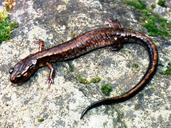|
Plethodon dunni Bishop, 1934
Dunn's Salamander Subgenus: Hightonia | family: Plethodontidae subfamily: Plethodontinae genus: Plethodon |
 © 2006 William Flaxington (1 of 33) |
|
|
|
Description Plethodon dunni sometimes co-occurs with the similar P. vehiculum. These species can be distinguished using the stripe that extends all the way to the tail tip in P. vehiculum, but does not reach the tip in P. dunni.(Stebbins 1985). Distribution and Habitat Country distribution from AmphibiaWeb's database: United States U.S. state distribution from AmphibiaWeb's database: California, Oregon, Washington
Among the western species of Plethodon, P. dunni inhabits some of the most mesic environments (Stebbins 1985), frequently semi-aquatic (Petranka 1998). In the rocky forest habitats preferred by this species, individuals may be found near seepages, streams, water falls, and other areas with rocky substrates (Nussbaum et al. 1983; Petranka 1998). At these sites animals will frequently be found in the splash zone or stream bank under rocks (Leonard et al. 1993). Populations also occur in moist talus slopes (Brodie 1970; Nussbaum et al. 1983; Leonard et al. 1993; Petranka 1998). Life History, Abundance, Activity, and Special Behaviors Seasonal activity depends on local climate. In warmer, coastal areas, Dunn's salamanders may be active year-round as long as the habitat remains moist (Nussbaum et al 1983). Animals are active primarily at night, when humidity is high, and retreat under cover objects during the day (Stebbins 1985). Surface activity is restricted in areas with cold winters or summer droughts (Petranka 1998). Diet consists of a large variety of small, terrestrial invertebrates including mites, annelids, isopods, millipedes, coleopterans, and dipterans (Altig and Brodie 1971; Petranka 1998). Adults occasionally eat juveniles (Riesecrer et al. 1996). Predators of P. dunni include Steller's Jay, and northwestern garter snake (Thamnophis ordinoides) (Nussbaum et al. 1983). Trends and Threats Comments See another account at californiaherps.com.
References
Altig, R. and Brodie, E. D., Jr. (1971). ''Foods of Plethodon larselli, Plethodon dunni, and Ensatina eschscholtzii in the Columbia River Gorge, Multnomah County, Oregon.'' American Midland Naturalist, 85, 226-228. Brodie, E. D., Jr. (1970). "Western salamanders of the genus Plethodon: Systematics and geographic variation." Herpetologica, 26(4), 468-516. Cole, E. C., McComb, W. C., Newton, M., Chambers, C. L. and Leeming, J. P. (1997). ''Response of amphibians to clearcutting, burning, and glyphosate application in the Oregon Coast Range.'' Journal of Wildlife Management, 61(3), 656-664. Corn, P. S. and Bury, R. B. (1989). ''Logging in Western Oregon: responses of headwater habitats and stream amphibians.'' Forest Ecology and Management, 29, 39-57. Corn, P. S. and Bury, R. B. (1991). ''Terrestrial amphibian communities in the Oregon Coast Range.'' Wildlife and Vegetation of Unmanaged Douglas-fir Forests. L. F. Ruggiero, K. B. Aubry, A. B. Carey, and M. H. Huff, eds., USDA Forest Service General Technical Report PNW-GTR-285, 304-317. Duellman, W. E., and Trueb, L. (1986). Biology of Amphibians. McGraw-Hill, New York. Dumas, P. C. (1955). "Eggs of the salamander Plethodon dunni in nature." Copeia, 1955, 65. Feder, J. H., Wurst, G. Z. and Wake, D. B. (1978). ''Genetic variation in western salamanders of the genus Plethodon, and the status of Plethodon gordoni.'' Herpetologica, 34, 64-69. Leonard, W.P., Brown, H.A., Jones, L.L.C., McAllister, K.R., and Storm, R.M. (1993). Amphibians of Washington and Oregon. Seattle Audubon, Seattle. Marco, A., Chivers, D. P., Kiesecker, J. M., and Blaustein, A. (1998). ''Mate choice by chemical cues in Western Redback (Plethodon vehiculum) and Dunn's (P. dunni) Salamanders.'' Ethology, 104(9), 781-788. Nussbaum, R. A., Brodie, E. D., Jr., and Storm, R. M. (1983). Amphibians and Reptiles of the Pacific Northwest. University of Idaho Press, Moscow, Idaho. Petranka, J. W. (1998). Salamanders of the United States and Canada. Smithsonian Institution Press, Washington D.C. and London. Riesecrer, J. M., Anderson, M. T., Chivers, D. P., Wildy, E. L., Devito, J., Marco, A., Blaustein, A. R., Beatty, J. J., and Storm, R. M. (1996). ''Plethodon dunni (Dunn's Salamander). Cannibalism.'' Herpetological Review, 27(4), 194. Stebbins, R. C. (1985). A Field Guide to Western Reptiles and Amphibians. Houghton Mifflin, Boston. Storm, R. M., and Brodie, E. D., Jr. (1970). ''Plethodon dunni Bishop. Dunn's Salamander.'' Catalogue of American Amphibians and Reptiles. American Society of Ichthyologists and Herpetologists, 82.1-82.2. Originally submitted by: Meredith J. Mahoney (first posted 1999-02-23) Edited by: M. J. Mahoney (2004-04-05) Species Account Citation: AmphibiaWeb 2004 Plethodon dunni: Dunn's Salamander <https://amphibiaweb.org/species/4129> University of California, Berkeley, CA, USA. Accessed Nov 22, 2024.
Feedback or comments about this page.
Citation: AmphibiaWeb. 2024. <https://amphibiaweb.org> University of California, Berkeley, CA, USA. Accessed 22 Nov 2024. AmphibiaWeb's policy on data use. |




 Raffaëlli Account
Raffaëlli Account Map of Life
Map of Life